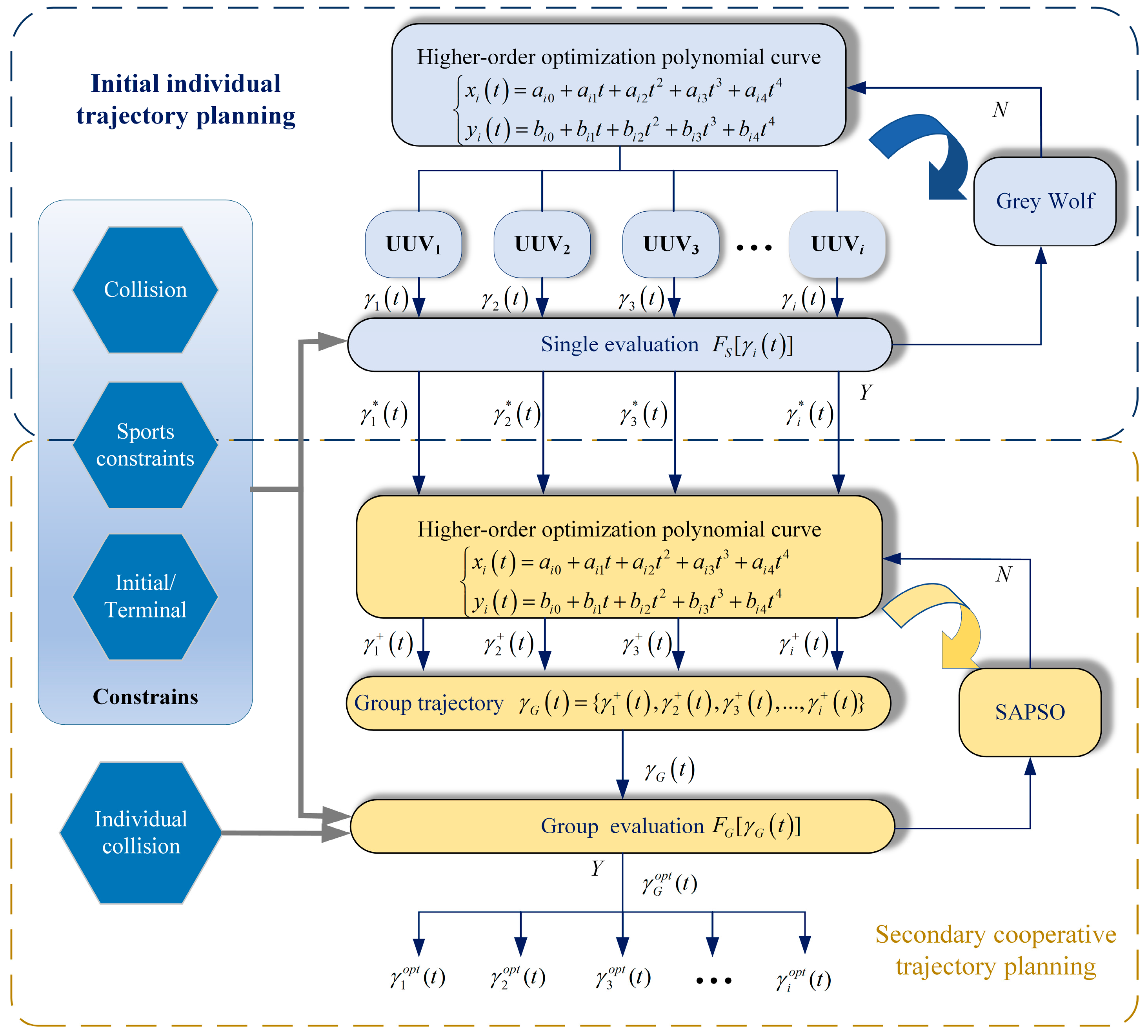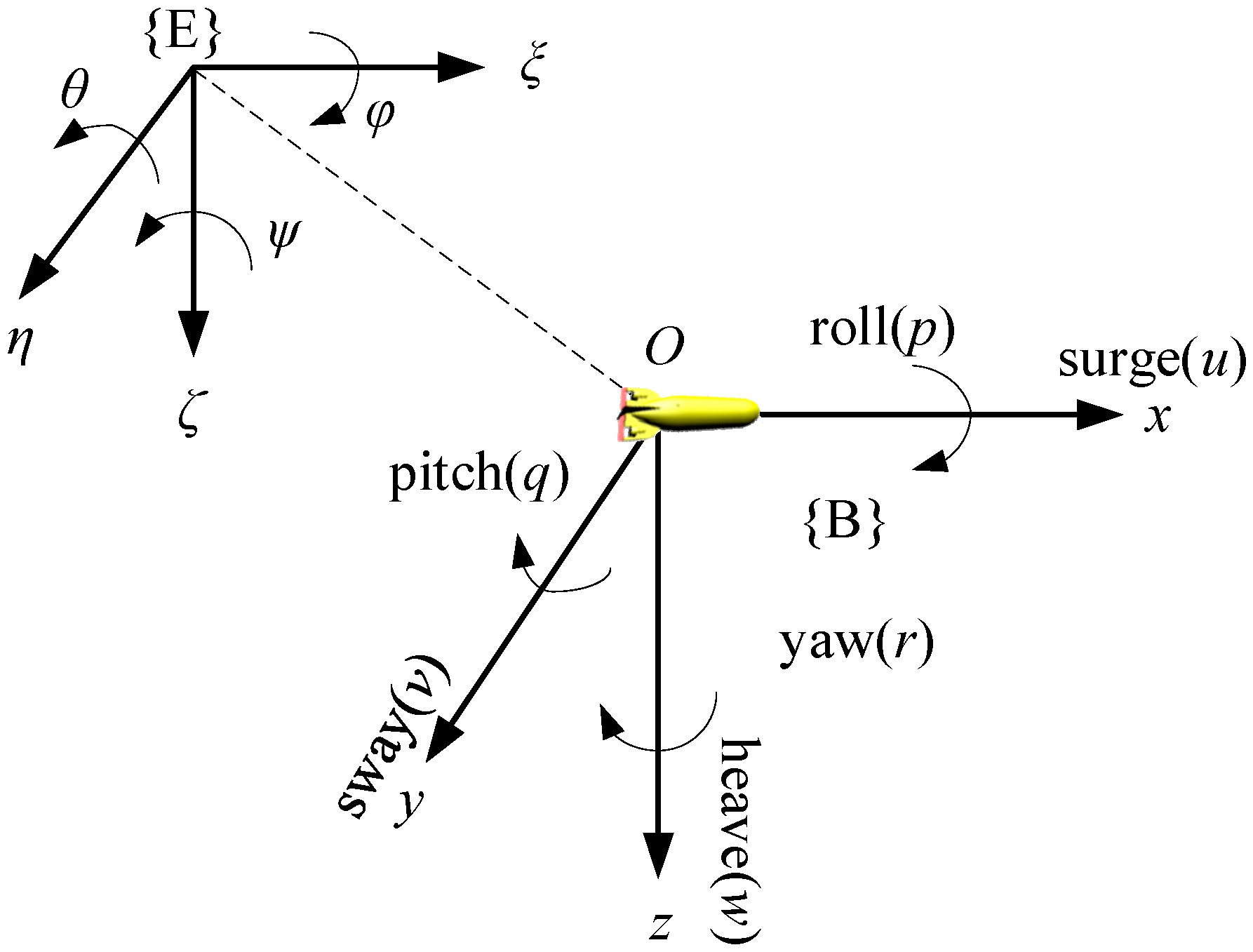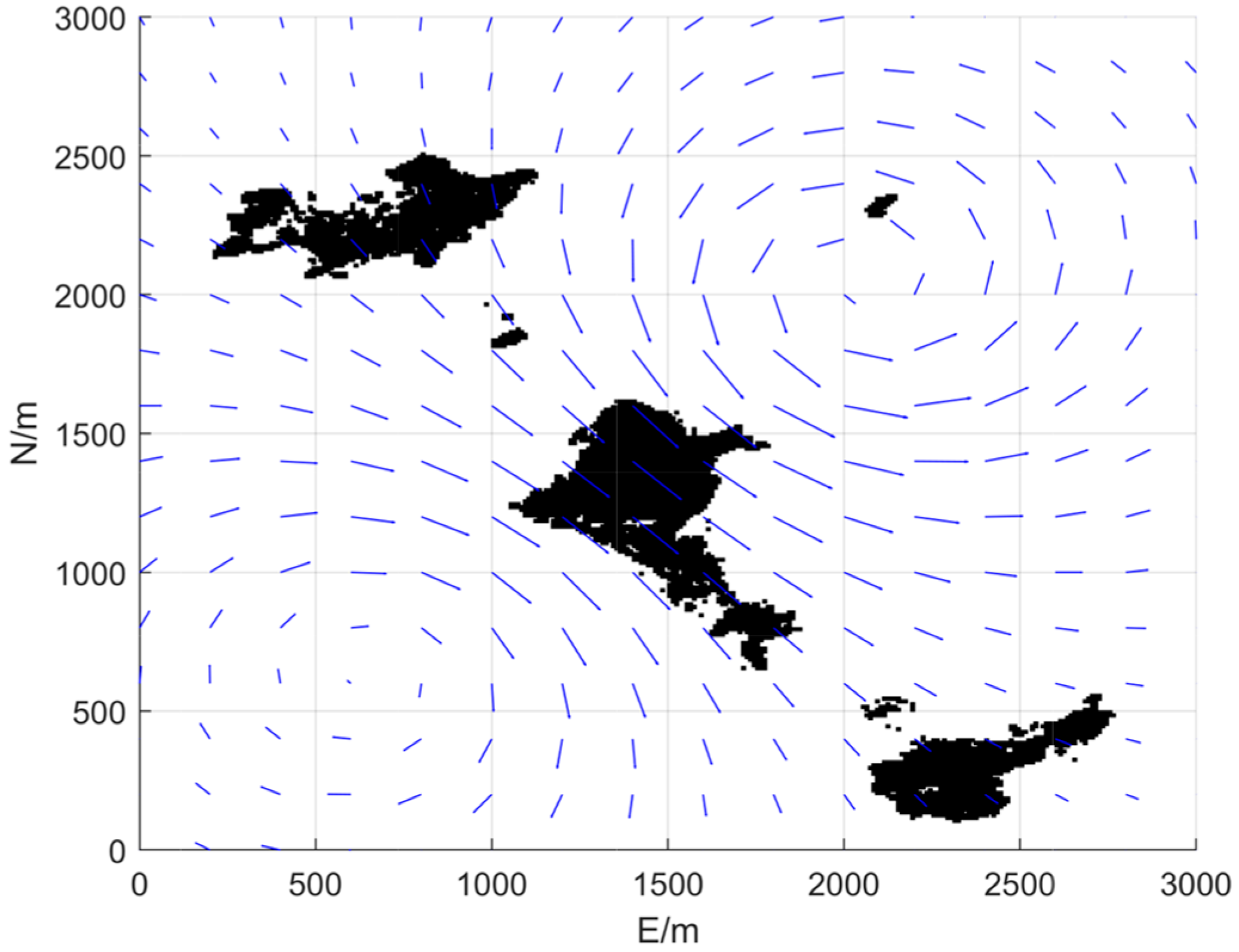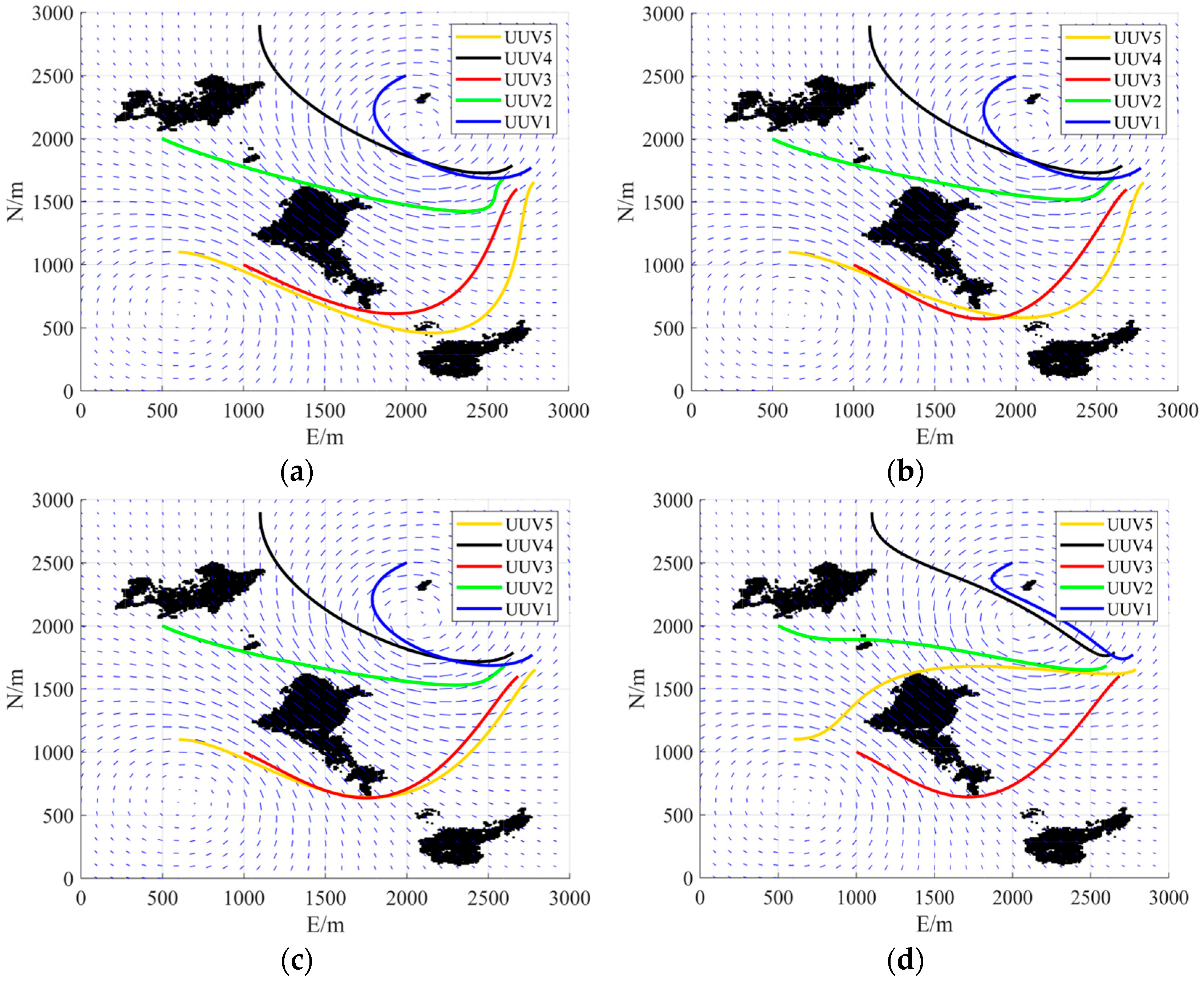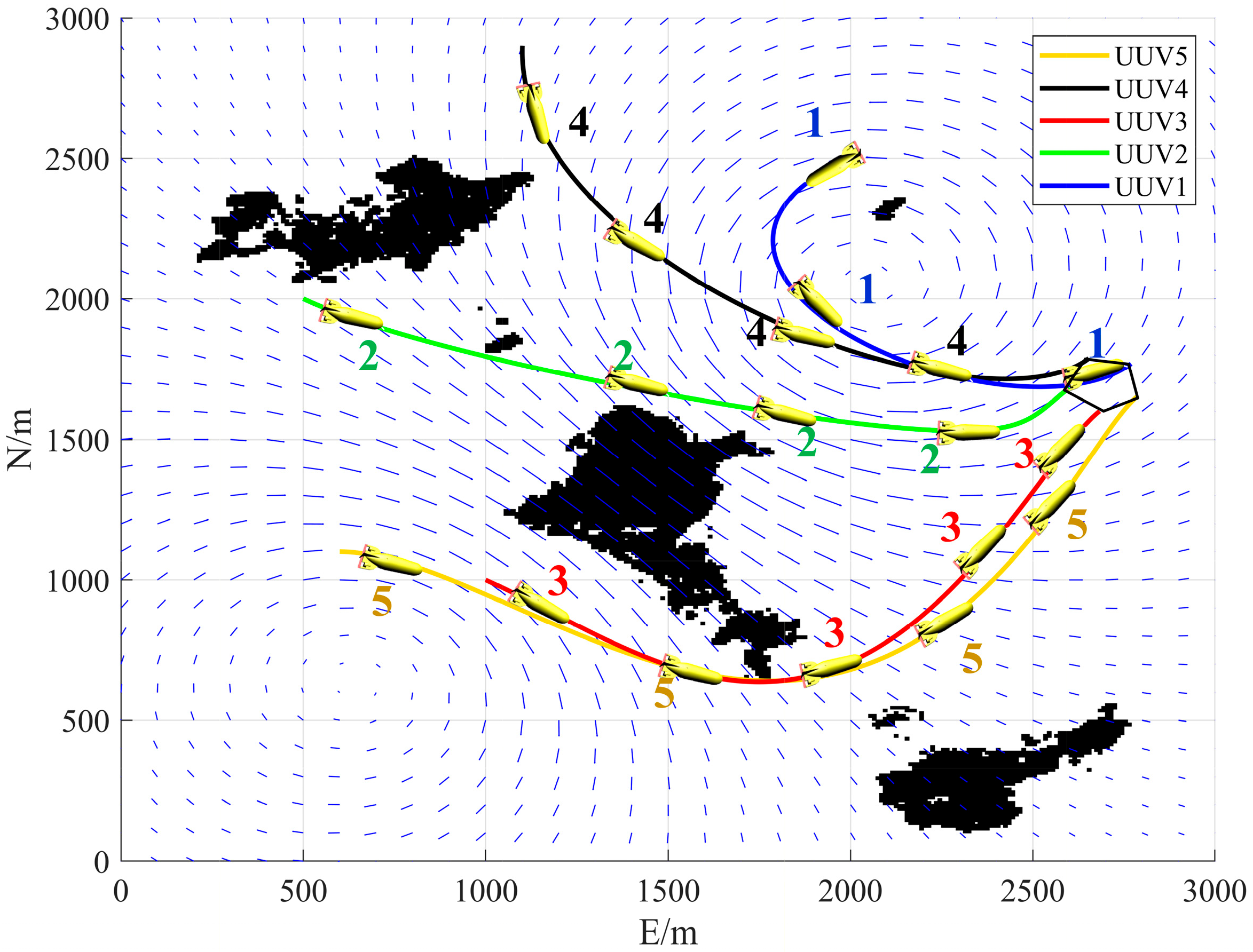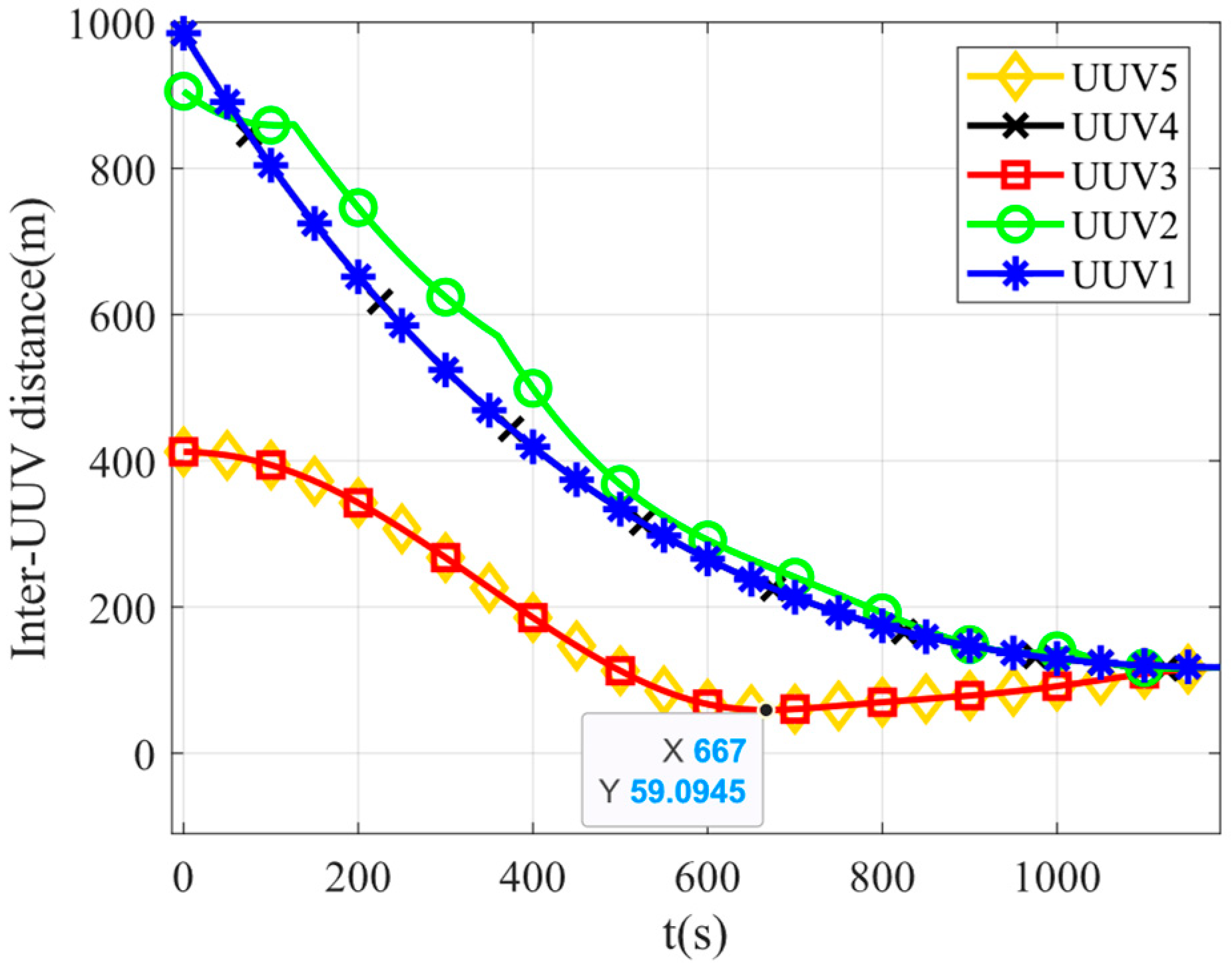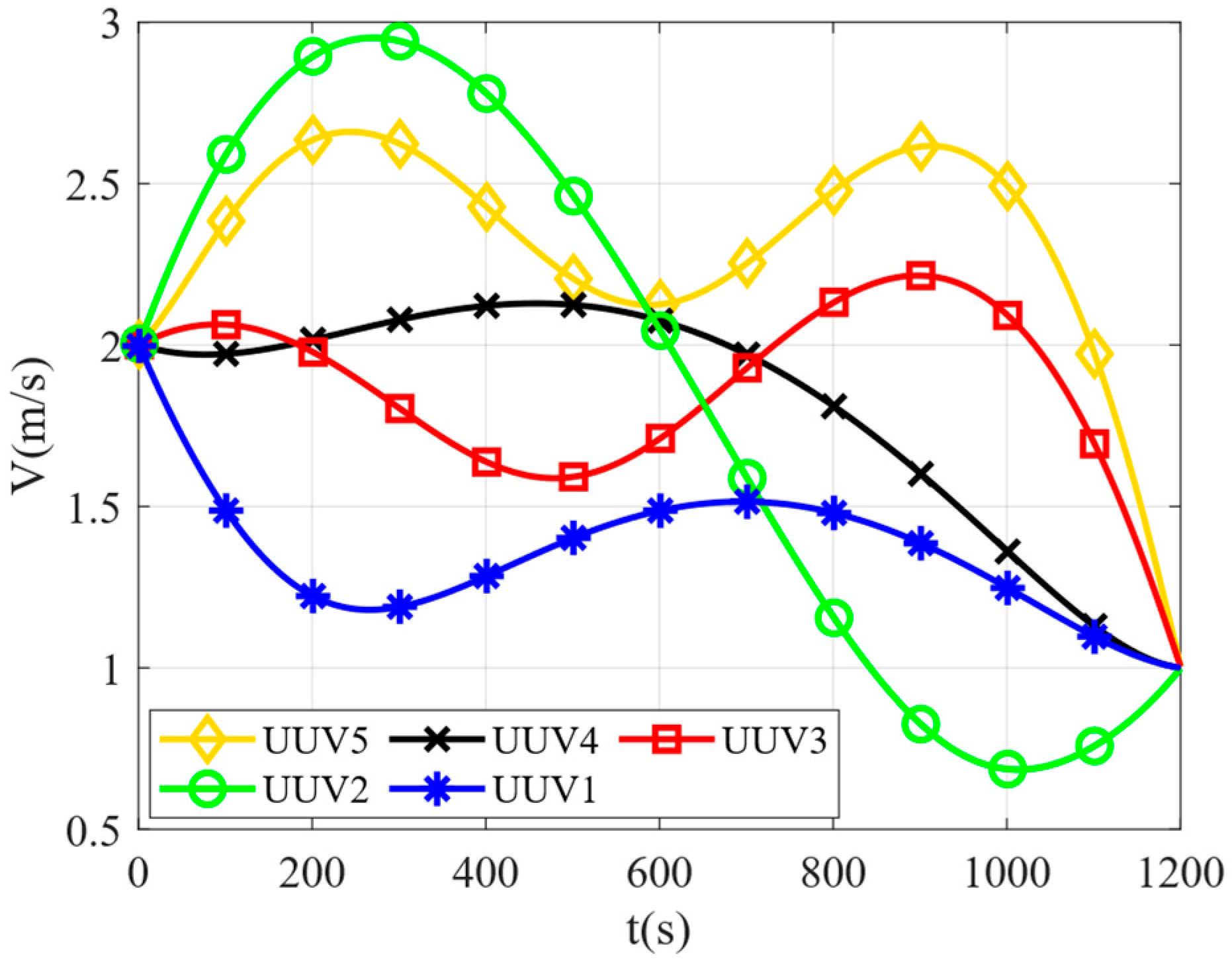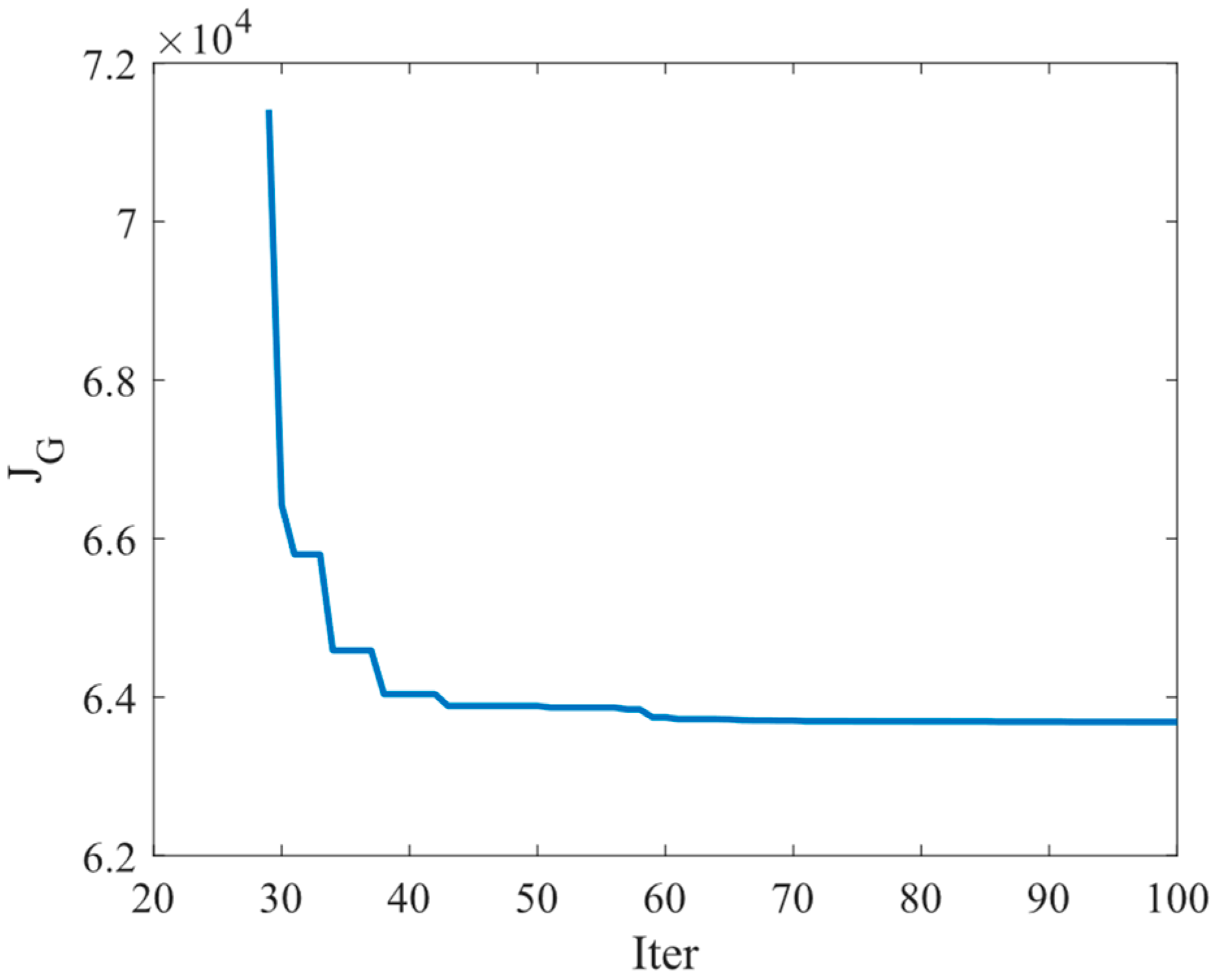1. Introduction
In recent years, with the continued expansion of fields such as exploration, resource development, and underwater search [
1], operations involving UUVs [
2] have become a prominent research focus. Formation rendezvous constitutes a critical phase during the deployment or recovery stages of cooperative UUV missions and represents one of the fundamental challenges in UUVs cooperative planning. The trajectory planning for multi-UUV formation rendezvous [
3] aims to generate trajectories for a group of initially dispersed UUVs from their respective starting points to a designated rendezvous location. This process requires all UUVs to arrive at the target point simultaneously at a specified time, achieve the desired formation upon convergence, and maintain consistency in motion states such as heading and velocity.
Regarding cooperative trajectory or path planning for multiple unmanned systems—such as UUVs, Unmanned Surface Vehicles (USVs), Unmanned Aerial Vehicles (UAVs), and Unmanned Ground Vehicles (UGVs)—current research efforts have predominantly concentrated on constraint management, optimization objectives, and the effective exploitation of environmental information.
Satisfying constraint conditions represents the primary consideration in formation rendezvous trajectory or path planning. These constraints typically encompass environmental limitations, vehicle-specific physical restrictions, and inter-agent relational requirements. Regarding obstacle avoidance constraints involving both static and dynamic obstacles during planning. Zhang et al. [
4] proposed a two-phase UUVs rendezvous path planning method. Their approach initially employs a fusion of artificial potential field and fish swarm trust search algorithms for global planning to identify critical sub-goal points. Subsequently, for addressing unknown threats, a bidirectional Rapidly-exploring Random Tree Star (RRT*) algorithm incorporating incomplete constraint rolling optimization is adopted for local real-time replanning. Addressing UUVs cooperative path planning and collision avoidance in obstacle-rich environments. Wu et al. [
5] developed a novel algorithm integrating Artificial Potential Field (APF) with A* search. By introducing inter-vehicle repulsive forces and temporary virtual target points, their method effectively resolves the local minimum problem inherent to traditional Artificial Potential Field (APF) methods, while leveraging the A* algorithm to ensure path feasibility in complex obstacle configurations. For constrained navigation through narrow spatial passages, Xing et al. [
6] presented an enhanced deep reinforcement learning scheme. Their solution incorporates an LSTM-enhanced MATD3 network, a novel dense reward function, and hierarchical training mechanism, significantly improving formation adaptability for UAVs. To address multi-task point access problems constrained by complex urban road networks and diversified mission durations, Yang et al. [
7] developed an Ant Colony Optimization (ACO) based coordinated path planning method for truck-mounted UAV swarms, incorporating kinematic constraints and mission time limitations. Their methodology first computes optimal UGV paths satisfying road network constraints, then discretizes them into docking points where optimal paths are planned for UAV swarms to visit multiple mission points. Concerning inter-agent constraints within clusters, Ma et al. [
8] established an online cooperative obstacle avoidance path planning method for AUVs. Their approach considers both temporal and spatial coordination aspects by establishing information sharing mechanisms to obtain real-time path data for coordination requirement assessment, with specifically formulated cooperative avoidance strategies ensuring spatiotemporal safety constraints among Autonomous Underwater Vehicle (AUV) clusters. Under comprehensive constraints including terrain threats, radar exposure, UAV turning angles, maximum flight distance, and altitude limitations, Geng et al. [
9] implemented crucial improvements to traditional Particle Swarm Optimization (PSO) by introducing opposition-based learning mechanisms. This strategy significantly enhances algorithmic search efficiency and global exploration capability, enabling rapid convergence to superior flight paths while strictly satisfying multiple complex constraints.
The objectives of cooperative path and trajectory planning vary significantly depending on the specific mission context [
10]. Y. Volkan et al. [
11] proposed an improved Genetic Algorithm (GA) solution. Their approach incorporated revisit time intervals and multiple runway strategies to enhance planning efficiency and feasibility in complex scenarios. With optimization objectives focusing on path length under constraints including minimum and maximum flight range, altitude limitations, and maximum turning angle. Lu et al. [
12] developed an Adaptive Differential Evolution (ADE) method to address modeling complexity and computational intensity in UAVs cooperative trajectory planning. For cooperative implementation, they adopted a distributed framework where PSO-ADE handles individual trajectory planning tasks, with trajectory feedback incorporated into the PSO velocity update formula to guide particle movement direction through cooperative path optimization. Luo et al. [
13]. proposed a self-adaptive optimization method considering key objectives including flight duration, path length, and energy consumption. Their methodology first constructs a multi-objective planning model centered on these core parameters, then designs an adaptive optimization algorithm enabling UAVs to autonomously select optimal paths through real-time adjustment of search step sizes and weight distributions. Anikó Kopacz et al. [
14], for the Multi Robot Path Planning (MPP) problem, collision free obstacles and collisions are used as constraints, and the shortest path is also taken as the optimization objective. A hybrid method combining A adaptive path planning and local search has been proposed. On the basis of ensuring the optimality of path search, this method extends to multi-agent scenarios through heuristic strategies to plan collision free optimal paths for multiple robots in a static environment. This study focuses on static conditions and does not consider other dynamic environments. V. H. A. Nguyen et al. [
15], take the length of the entire path as the optimization objective and add an optimization term for the smoothness of the path. Propose an improved RRT algorithm that combines the advantages of RRT PSO and Informed RRT*, and adopts a trapezoidal turning optimization strategy to replace path corners, significantly improving path smoothness and robot motion feasibility. Similarly, it is based on a completely static environment. In multi-system cooperative planning, the strategic utilization of environmental elements as active resources has emerged as a novel research direction. For AUV operations in current environments, Gong et al. [
16] modeled current influences as longitudinal and lateral velocity components affecting AUV navigation, while incorporating trajectory length into energy consumption optimization objectives. Their approach employs ant colony optimization to resolve multi-trajectory planning problems, enabling flexible trajectory selection for AUVs according to specific mission metrics. Addressing the energy disparity challenge in airborne UAV formation rendezvous caused by varying initial potential energy under diverse wind conditions, Wang et al. [
17] proposed a wind energy harvesting strategy integrated into collective trajectory planning. Through analysis of tailwind, headwind, no-wind, and crosswind scenarios, their method enhances solution efficiency via simplified collocation and intelligent initialization strategies, enabling individual members to compensate for energy costs through independent wind energy harvesting while planning respective trajectories. For AUVs cooperative operations in marine environments with multiple vortex currents and obstacles, Li et al. [
18] developed a hybrid algorithmic framework combining K-means preprocessing, distributed auction-based task allocation, and Deep Neural Network (DNN) path planning. This methodology integrates path length with current compliance to modulate neuronal activity intensity during post-allocation path planning, significantly improving mission execution effectiveness in complex scenarios. Wang et al. [
19] proposed a method for assigning intersection points and planning formation intersection trajectories based on dynamic parameter particle swarm optimization (DPPSO) to optimize polynomial trajectories has been proposed. Taking into account kinematic constraints, collision avoidance constraints between clusters, and other constraints, the energy optimization objective is to minimize the cumulative trajectory length. However, obstacle avoidance constraints and energy consumption requirements of ocean currents were not included in the evaluation of trajectory planning. Shao [
20] et al. To meet the kinematic constraints of maximum curvature and continuous path curvature for unmanned aerial vehicles (UAVs), and considering collision avoidance constraints between obstacles and clusters, a path planning method based on pH curve was proposed. The distributed collaborative particle swarm optimization (DCPSO) algorithm with elite preservation strategy was adopted to generate a safe and flight path for each UAV.
Previous studies have rarely comprehensively considered multiple constraint conditions and utilized environmental flow fields to achieve energy optimal collaborative trajectory or path planning. At the same time, when various constraints and optimization terms are coupled with each other, there is room for improvement in this area of research To address this gap, this paper proposes a dual-layer planning framework for multi-UUV formation rendezvous trajectory planning in environments with obstacles and currents. This method decouples the complex multi-UUV trajectory planning problem into two sequential phases: initial individual trajectory planning layer and a secondary cooperative planning layer, effectively separating individual and collaborative trajectory planning, ultimately generating formation rendezvous trajectories that satisfy all constraints while achieving optimal energy consumption.
The remainder of this paper is organized as follows:
Section 2 formulates the multi-UUV formation rendezvous problem and specifies the corresponding constraints and optimization objectives.
Section 3 presents the core methodology of this work—the dual-layer planning framework.
Section 4 provides a detailed exposition of the initial individual trajectory planning approach.
Section 5 introduces the secondary cooperative trajectory planning approach.
Section 6 presents and analyzes the simulation results. Finally,
Section 7 concludes the paper with a summary and concluding remarks.
3. Dual-Layer Planning Framework
This section is the core part of the article, aiming to achieve decoupling of various constraints and optimization objectives in the planning of individual and cluster trajectories in UUV rendezvous trajectory planning. Conventional integrated cooperative planning methods typically address all motion constraints and optimization objectives for multi-UUV trajectories at a single level [
19]. However, in marine environments where obstacles and currents coexist, the pursuit of energy-optimal solutions under multiple coupled constraints—including obstacle avoidance, inter-UUV collision prevention, kinematic limitations, and terminal rendezvous consistency—renders the formation rendezvous trajectory planning problem highly complex. These high-dimensional, strongly constrained optimization problems impose significant computational burdens and are prone to local optima, often failing to yield feasible solutions that satisfy all constraints within limited timeframes. These limitations severely restrict the practical applicability of such methods in marine environments. Therefore, this article transforms the complex multi-objective optimization problem mentioned above into the hierarchical optimization problem mentioned in reference [
24]. Divide the optimization objectives and constraints during the formation rendezvous process into two planning layers: individual and group. This paper proposes a dual-layer planning framework for multi-UUV formation rendezvous trajectory planning. The initial individual trajectory planning layer generates input information for the secondary cooperative planning layer. In the secondary collaborative planning layer, as the rendezvous trajectories of each UUV are fine tuned, emphasis is placed on considering collision avoidance constraints between groups, while also taking into account all individual constraint terms such as starting and ending point state constraints. For any set of trajectories that do not meet the UUV constraint conditions, they should all be discarded and iteratively searched for the next set of trajectories that can meet them. All “optimizable individual trajectories” should be synchronized and optimized as a whole “cluster trajectory”. This is the core idea of ensuring that all team rendezvous constraints are met. The overall architecture is illustrated in
Figure 2.
The proposed dual-layer planning framework consists of an upper initial individual trajectory planning layer and a lower secondary cooperative planning layer. The core idea is to separate individual constraints from group constraints, with optimal energy consumption as the optimization objective. The second layer (collaborative planning) serves as the upper layer optimization, with the goal of coordinating the solutions (individual trajectories) provided by the lower layer to meet the constraints and objectives of the formation. In the initial individual trajectory planning layer, the trajectory
of each individual UUV is input into the single-UUV trajectory evaluation function
, and the GWO algorithm is employed to optimize high-order terms of polynomial curves. This generates initial single-UUV trajectories
that aim for energy optimality while satisfying obstacle avoidance, kinematic constraints, and state requirements, which then serve as input information for the secondary cooperative planning layer. In the secondary cooperative planning layer, in addition to maintaining the constraints from the single-UUV trajectory planning phase, inter-UUV collision avoidance constraints are additionally considered. Based on the optimal individual trajectories
of each UUV, the secondary layer correspondingly generates new optimizable individual trajectories
. Subsequently, during the formation rendezvous trajectory planning process, all optimizable individual trajectories
are simultaneously optimized as a collective cluster trajectory
, where all UUV trajectories collectively form the optimization variables instead of single UUV trajectories, and are input into the secondary cooperative UUV trajectory evaluation function
. The SAPSO algorithm is then applied for iterative optimization to obtain the optimal collective formation rendezvous trajectory
, from which the optimal rendezvous trajectories for each individual UUV
are derived. This is the difference between the methods used in this article and other literature such as [
19], which no longer consider multiple constraints and optimization conditions at the same level, but instead achieve decoupling of constraints and optimization in individual and group planning.
6. Simulation Verification
To validate the effectiveness of the proposed dual-layer planning framework for multi-UUV formation rendezvous trajectory planning, this section presents simulation experiments. Initially, a realistic marine environment with coexisting obstacles and currents is constructed. A 3 km × 3 km satellite map of a selected area in the East China Sea is utilized to create a grid-based map model [
33] using the grid method. Subsequently, a current model is established based on the classical Lamb dipole vortex model, which accurately captures key characteristics of full-range intensity variations in practical currents. The impact of vortex flow is abstracted as surge and sway velocity components
and
generated at specific points.
Assume the constant value of the eddy current intensity
in the first vortex field is 1000, with an effective radius
of 500, and the vortex center is located at (750 m, 750 m). For the second vortex field, the constant value of vortex intensity
is 1200, with an effective radius
of 400 m, and the vortex center is positioned at (2000 m, 2000 m). The plotting scale is set to 300 m, meaning currents are visualized at 300 m intervals. The obstacles and current environments constructed in this article are shown in
Figure 5, where black areas represent obstacles and blue arrows represent currents.
Assume five UUVs are deployed to execute a formation rendezvous mission, to form a pentagonal formation at the designated area. The relevant rendezvous boundary conditions are specified in
Table 1, and the associated parameter configurations are detailed in
Table 2, Among them, values without units are constant parameters.
Considering the four cases presented in the table, four simulation experiments were conducted to validate the dual-layer formation rendezvous trajectory planning method under different weighting coefficient scenarios. The simulation results are shown in
Table 3.
Table 3.
Evaluation results of trajectory length and current energy consumption.
Table 3.
Evaluation results of trajectory length and current energy consumption.
| Case | Trajectory Length | Current Energy Consumption Value |
|---|
| Case 1 | 11.61 × 103 m | 6.26 × 103 |
| Case 2 | 11.31 × 103 m | 7.16 × 103 |
| Case 3 | 11.01 × 103 m | 8.65 × 103 |
| Case 4 | 10.11 × 103 m | 20.74 × 103 |
Considering the four cases presented in the table, four simulation experiments were conducted to validate the dual-layer formation rendezvous trajectory planning method under different weighting coefficient scenarios. The simulation results are shown in
Table 3.
As shown in
Figure 6 and
Table 3, the energy consumption values of currents in
Table 3 are normalized dimensionless values without physical units and are used for subsequent comparative analysis. with the progressive increase in the weighting coefficient for UUV trajectory length, trajectory length increasingly dominates the planning process. Simultaneously, the formation rendezvous trajectory of the UUVs aligns with the current direction to achieve energy conservation objectives.
In Case 1, where the trajectory length proportion is minimized at 50%, the configuration achieves the optimal current energy consumption evaluation value among Cases 1–4.
As the trajectory length weighting increases to 75% in Case 2, the total trajectory distance shortens from 11.63 × 103 in Case 1 to 11.31 × 103, accompanied by noticeable modifications in the trajectory curvature. Consequently, the corresponding energy consumption attributed to currents changes to 7.16 × 103.
In Case 3, with the trajectory length weighting set at 83%, the UUV trajectory becomes noticeably shorter in the graphical representation, and the specific trajectory length value decreases to 11.01 × 103. Meanwhile, the energy consumption evaluation value for currents increases as the trajectory length weighting grows, indicating a reduced compliance with currents.
In Case 4, where the trajectory length weighting reaches 100% and thus completely disregards current factors, the resulting trajectory achieves the shortest possible length but corresponds to the worst current energy consumption evaluation value, recorded as 20.74 × 103.
The subsequent analysis of constraint conditions and optimization results will be based on the outcomes from Case 3.
As shown in
Figure 7, the number represents the number of the UUV and is distinguished by color. All UUVs depart from their initial points without colliding with obstacles and arrive at their designated rendezvous positions to form a pentagonal formation. To better visualize the minimum distance between each UUV, let
represent the minimum distance between the
-th UUV and any other
-th UUV at any time
, with the specific expression given by Formula (37).
As shown in
Figure 8, the vertical axis Inter-UUV distance(m) represents the minimum distance from each UUV to the other UUVs, and the vertical axis represents time(s). The minimum distance between any two UUVs is 59.10 m, and at any given moment, all inter-UUV distances exceed the predefined safety threshold
.
As shown in
Figure 9, The vertical axis represents the navigation speed(m/s) of UUV, the vertical axis represents time(t). The velocities of all UUVs range between 0.68 m/s and 2.95 m/s, which aligns with the achievable speed range of UUVs. Upon reaching the rendezvous points, all UUVs achieve the preset desired velocities, satisfying the velocity constraints at the rendezvous points.
According to
Figure 10, the horizontal axis represents angular velocity r(°/s), and the vertical axis represents time(t). The maximum heading angular velocity observed among all UUVs is 0.46°/s, demonstrating compliance with the turning motion constraints in their trajectories.
Figure 11 displays the minimum distances from each UUV to all obstacle grids. The vertical axis UUV-Obs distance(m) represents the minimum distance from each UUV to the obstacles, and the vertical axis represents time(s). The UUV5 maintains the closest proximity to obstacles with a minimum distance of 6.45 m, confirming that all UUVs successfully avoid collisions with obstacles.
During the simulation, the predefined optimization objective function served as the evaluation criterion for the SAPSO algorithm. When the algorithm iterated until the evaluation function converged to a stable minimum value, this indicated that the high-order optimization terms yielding the optimal objective function had been obtained, thereby determining the optimal formation rendezvous trajectory for the multi-UUV system.
As shown in
Figure 12, the algorithm ultimately converged to solution 6.36 × 10
4. The comprehensive analysis of these results verifies the feasibility of the obtained formation rendezvous trajectory.
In the simulation experiment, we found that we discussed a key unexpected finding: in the ocean current environment, simply pursuing the geometric shortest path (i.e., assigning excessive weight to the “trajectory length” in our method) can actually lead to a significant increase in total energy consumption. In contrast, by taking reasonable values for length and energy consumption, UUVs can be guided to plan moderately circuitous trajectories that can effectively “leverage” the ocean current, thereby achieving better energy consumption performance globally.
7. Conclusions
Formation rendezvous trajectory planning represents a critical challenge in multi-UUV system coordination, particularly in environments with obstacles and currents. The core complexity lies in simultaneously addressing multiple constraints including obstacle avoidance, inter-UUV collision prevention, kinematic limitations, and rendezvous timing synchronization, while maintaining energy-optimal performance as the primary objective. This paper systematically investigates this problem and innovatively proposes a dual-layer planning framework for cooperative trajectory planning.
This method decouples the conventional integrated cooperative planning problem into two hierarchical stages: initial individual trajectory planning and secondary cooperative trajectory planning. In the initial planning layer, the GWO is employed to optimize high-order polynomial curves, comprehensively considering multiple objectives including obstacle avoidance, kinematic constraints, collision prevention, and energy consumption. This process generates initial trajectories for each UUV, serving as inputs to the cooperative layer. In the secondary cooperative planning layer, building upon the initial trajectory information, the SAPSO algorithm performs coordinated exploration within the solution space, ultimately producing globally optimal formation rendezvous trajectories that satisfy all constraint conditions.
Simulation results demonstrate that the proposed dual-layer planning method effectively handles multiple constraints, generating formation rendezvous trajectories that satisfy velocity and angular velocity constraints while ensuring collision avoidance between UUVs and between UUVs and obstacles. Furthermore, by adjusting the weighting coefficients for currents and trajectory length, the method achieves coordinated optimization of UUVs trajectories to minimize energy consumption. These findings validate the effectiveness and superiority of the proposed approach in addressing the multi-UUV formation rendezvous trajectory planning problem.
The current research of the article focuses on verifying the use of a two-layer optimization method to solve the problem of obstacle and multi-UUV rendezvous trajectory planning in the current environment. In practical applications, based on the research in this article, more attention should be paid to the feasibility of planning and real-time planning time to evaluate whether the planning effect is ideal. A broader comparison with general and state-of-the-art multi-layer optimization techniques is an important research direction for the future. In future research, we will increase ocean experiments to consider the impact of the ocean on the solid hull control of unmanned underwater vehicles, while also increasing the number of UUVs performing tasks. Through three-dimensional trajectory planning, we will study the impact of different optimization methods on the overall efficiency of task execution, in order to further improve its engineering practicality.

